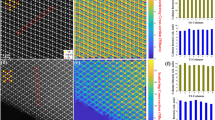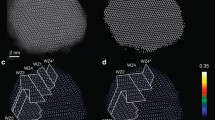Abstract
Nonstoichiometry of tetradymite-type crystals A V2 B VI3 that are grown from stoichiometric melts leads to the formation of native defects in the crystal lattice (predominantly antisite defects, A −1B and vacancies V +2B in the anion sublattice). This paper summarizes the basic ideas concerning a point defect model in A V2 B VI3 crystals. It turns out that a variety of doping elements interact with the native defects. Such interactions alter the concentration of free charge carriers, affect the doping efficiency, and modify the transport properties. Detailed understanding of the defect structure in tetradymite-type crystals is very important as it impacts on the efficiency of these materials when used as active elements in thermoelectric coolers.
Similar content being viewed by others
References
H. Krebs, Grundzüge der Anorganishen Kristallchemie (Stuttgart: F. Enke Verlag, 1968), p. 239.
G.S. Nolas, J. Sharp, and H.J. Goldsmid, Thermoelectric Basic Principles and New Materials Developments (Berlin: Springer, 2001), p. 111.
G.R. Miller and C.-Y. Li, J. Phys. Chem. Solids 26, 173 (1956).
R.F. Brebrick, J. Phys. Chem. Solids 30, 719 (1969).
G. Offergeld and J. van Cakenberghe, J. Phys. Chem. Solids 11, 310 (1959).
C.B. Satterthwaite and R.W. Ure, Phys. Rev. 108, 1164 (1957).
L.V. Poretskaya, N.Kh. Abrikosov, and V.M. Glazov, Zh. Neorg. Khim 8, 1196 (1963).
F.A. Kröger, J. Phys. Chem. Solids 7, 276 (1958).
B.T. Kolomiets and T.F. Nazarova, Fiz. Tverd. Tela 2, 22 (1959).
H. Gobrecht, K.F. Boerets, and G. Pantzer, Z. Phys. 177, 68 (1964).
I.F. Bogatyrev, A. Vasko, L. Tichy, and J. Horak, Phys. Status Solidi A 22, K63 (1973).
J. Horak, P. Lostak, C. Drasar, J.S. Dyck, Z. Zhou, and C. Uher, J. Solid State Chem. 178, 2907 (2005).
P. Lostak, C. Drasar, J. Horak, Z. Zhou, J.S. Dyck, and C. Uher, J. Phys. Chem. Solids 67, 1457 (2006).
J. Bludska, I. Jakubec, C. Drasar, P. Lostak, and J. Horak, Philos. Mag. 87, 325 (2007).
N. Frangis, S. Kuypers, C. Manolikas, J. van Landuyt, and S. Amelinckx, Solid State Commun. 69, 8 (1989).
N. Frangis, S. Kuypers, C. Manolikas, G. van Tendeloo, J. van Landuyt, and S. Amelinckx, Solid State Chem. 84, 314 (1990).
C. Drasar, I. Klichova, L. Koudelka, and P. Lostak, Cryst. Res. Technol. 31, 805 (1996).
P. Lostak, C. Drasar, D. Bachan, L. Benes, and A. Krejcova, Radiat. Eff. Defects Solid (accepted).
T. Plechacek, J. Navratil, J. Horak, D. Bachan, A. Krejcova, and P. Lostak, Solid State Ionics 177, 3513 (2007).
D. Bachan, A. Hovorkova, C. Drasar, A. Krejcova, L. Benes, J. Horak, and P. Lostak, J. Phys. Chem. Solids 68, 1079 (2007).
Author information
Authors and Affiliations
Corresponding author
Rights and permissions
About this article
Cite this article
Drasar, C., Lostak, P. & Uher, C. Doping and Defect Structure of Tetradymite-Type Crystals. J. Electron. Mater. 39, 2162–2164 (2010). https://doi.org/10.1007/s11664-009-0986-x
Received:
Accepted:
Published:
Issue Date:
DOI: https://doi.org/10.1007/s11664-009-0986-x




